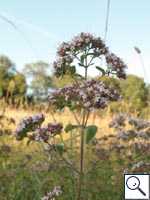|
||||||
|
ORIGANUM. Wild Marjoram. [Lamiaceae] |
|
|
Wild Marjoram (O. vulgare) is the only species of Origanum recorded in Britain. It is a native species. Two British miners are recorded on Origanum. A key to the European miners recorded on Origanum is provided in Bladmineerders van Europa. |
 Wild Marjoram Origanum vulgare |
Key for the identification of the known mines of British |
1a > Leaf-miner: Mine beginning with small spiral, followed by a linear section to the margin of the leaf where a dark blotch is formed. Pupation internal (Spencer, 1972b: 86 (fig. 292), 90; Spencer, 1976: 464, 465 (fig. 813)). Essentially a corridor mine. It begins as a tiny upper-surface spiral. The corridor at this point is so narrow and closely wound that it rather resembles a simple spot. Next follows a simple corridor running towards the leaf tip, often following the leaf margin for some distance. In the leaf apex a quite long corridor is made, while the mine is laid in loops that are so close that a secondary blotch results, with prominent secondary feeding lines. The final section of the mine again is a simple corridor, in the end of which pupation takes place. Before pupating the larva already has made a semicircular slit in the epidermis. Not infrequently the puparium falls out (Hering, 1957). The initial mine is a small spiral. The mine then follows the edge of the leaf and a dark blotch is formed. Pupation is within the mine. |
|
Phytomyza origani Hering, 1931 [Diptera: Agromyzidae]. |
1b > Leaf-miner and case-bearer: Blotch mines reaching the edge of the leaf, initially pale green turning brownish white, are caused by the larva feeding on the underside of a leaf. The fully developed case is slender, shining black brown, about 9 mm long. Towards the end a narrow, transparent yellowish ventral keel. Mouth angle 50-60°. Cases on the leaf underside. |
|
Coleophora albitarsella Zeller, 1849 [Lepidoptera: Coleophoridae]. |
| Last updated 06-Jul-2019 Brian Pitkin | ||
